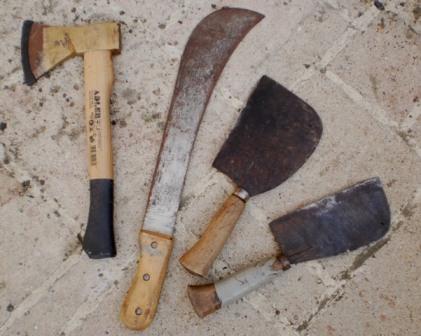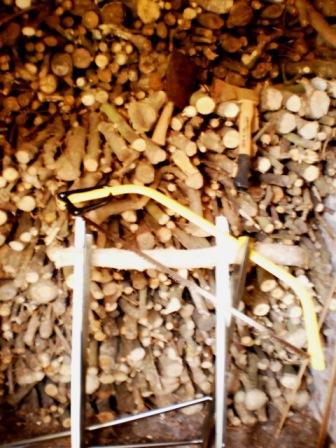Coppice stands in a sort of shrub woods where the wood is harvested regularly. Depending on the rate of growth this happens once it has the desired thickness, and before it’s too thick and heavy and possible tears apart.A coppice stump (low-cut) retains its root system, giving new wood an advantage of 3 to 5 times more growth than new plantings.
The difference between coppice and pollarding is in the height of the remaining strain.
In pollarding it is so high that the cattle cannot gnaw on the new shoots (or where the crown starts) and if possible low enough to be easy to handle. So, usually at about 160 cm. (Most on willow.)
Coppice is chopped low to the ground (or cut). The chair or stove is the solid foundation stump that remains . A chair is the stump of the severed branch or trunk, from which new scions jet. Thus, there remains one root system containing multiple strains. The stumps make new trunks, branches and buds .
 The harvested wood is used in a wood cascade as firewood, clogs, poles, handles (tool shanks), brushwood ( supports on which peas or beans in the yard climb up), fagots or twig bundles to stoke the bread oven, dead hedge, knitting needles, wicker-work (windshields, walls, baskets) and brooms skewers , brushes, toothpicksas .
The harvested wood is used in a wood cascade as firewood, clogs, poles, handles (tool shanks), brushwood ( supports on which peas or beans in the yard climb up), fagots or twig bundles to stoke the bread oven, dead hedge, knitting needles, wicker-work (windshields, walls, baskets) and brooms skewers , brushes, toothpicksas .
If you fell (or truncate) trees you do not cut just everything to firewood. Make a wood selection for the most valuable applications, you can always use it as firewood later. Think first timber, poles, shaft, handle, bean poles, support poles for tomatoes, wicker , support for peas. Old material that you replace is still as good firewood.
Ash (Fraxinus excelsior) is truncated once every 5 to 7 years, alder and willow every 6 to 10 years, oak every 10 to 15 years. Almost all native deciduous trees can be used for this purpose, including linden, elm, hornbeam and sweet chestnut.
Less used are beech, birch and sweet cherry.
Pollarding and chopping is done when the trees are at rest, so wear no more leaves, and if it is not (hard) freezing . That is usually between November and March. Some tree species are sensitive to 'bleed ' (juice outflow). Pollard them in preference before New Year: maple and wild cherry trees.
Don’t cut the complete branch but leave a stump of which the length is about the same size as the diameter of the cut branch.
Do not cut horizontally but diagonally, so that rainwater can flow of. When cutting you should also avoid tearing the bark as the branch falls: first cut a notch on the bottom and side of the branch.
You may also provisionally leave a heater big stump (30 or 40 cm) and saw this when the heavy branch is off.
 If you start with chopping or pollarding you should continue to do, otherwise the branches become over years too heavy for the trunk or roots and eventually tear the whole open, especially in truncated stumps.
If you start with chopping or pollarding you should continue to do, otherwise the branches become over years too heavy for the trunk or roots and eventually tear the whole open, especially in truncated stumps.
Willows are often planted in large numbers on and around wet plots. Knotting then becomes quite a job. But you better not do it all at once. Preferably every 3 or 4 trees (years), possibly with a year in between. Many small bee species (and other insects) survive thanks to the early flowering willows.
Willow is a very "useful" tree, the bark provides the drug with acetylsalicylic acid for headache, the growth hormone auxin for seedlings and plants, winter forge, binding material, braiding material for baskets and mud walls, hoops, and wood for clogs.
The bark of the oak was used for bark liquor to tan leather. The remaining peeled wood for poles. For the eel- , meat and sausage smokehouses oak was used.
In Sweden, young shoots of lime trees with leaf, twig and fruit were preserved as winter feed for cattle.
On slopes along roads and riverbanks coppice can prevent erosion. The soil is retained by the roots. Because there never are too high trees, they do not fall over or are blown.
There are projects to grow coppice under power lines for wood chips that are used to produce green energy.
First make charcoal of firewood that you only can harvest far away, it is just much lighter to transport.
I had a series of willows standing around my pasture. I've never pruned them all at once. In even years I chopped every winter afternoon one or a few branches off an even tree. The bark is fine sheep feed, they like to nibble the branches. In odd years I did the odd trees. (See <Winter food>)
A ‘schalm’ (in Flanders) is (not only a link in a chain, but also) a defined plot in a forest where you were allowed to harvest all the coppice (with or without payment). The undergrowth stakes (or middle wood) had to stay below a specified thickness and length. The size of the coppice plot or the cut was also called coupe. Putting on save twigs (or on ones) means that one offspring per stump was spared to get high wood or stayers (rising trees that remain (longer)).
A ‘pestilence grove’ was created in the past on an enclosed spot where the bodies of the cows and cattle died of the plague were buried. That area was not grazed or mowed to avoid contamination. Therefore it slowly became bush.
See also <Wood> , <Felling trees > and <Raising (Crown lifting)> under < Housing >)
